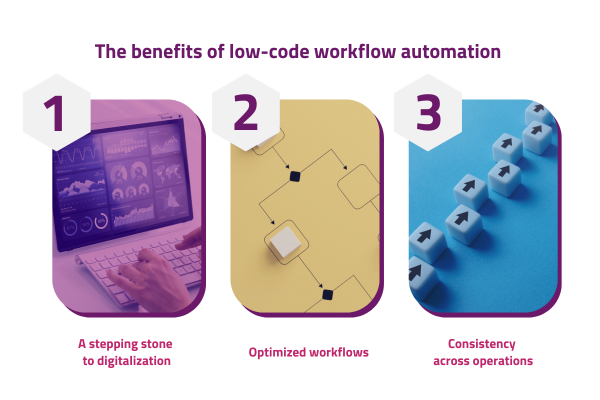The administrative and support roles in your organization’s back office serve as the backbone of your organization. Back-office staff ensures smooth operations, and in return, they require your support. One way to do this is by making their job easier by introducing low-code workflow automation to modernize back-office functions, enhancing efficiency and contributing to an overall more effective system.
In theory, workflow automation sounds simple: it entails using technology to execute tasks that were previously manually handled by humans. Yet, in reality, it can be a time-consuming process, and for organizations not yet on the digital transformation journey, getting started with complex workflow automation might appear overwhelming.
This blog post will guide you through the process of automating your back-office or business workflows: why it’s essential, how to get started with it, and what to keep in mind to avoid common pitfalls.
Why does your company need a low-code workflow automation strategy for 2024?
The primary purposes of business process automation, such as accelerating repetitive tasks, ensuring consistency, and minimizing human error, are undeniably important for any organization that wants to survive, but that’s not all there is to it.
Let’s look at some of the main reasons why low-code workflow automation will be critical going forward:
1. Low code is a stepping stone to digitalization
By improving a select few processes that clearly require correction with low-code solutions, organizations can gradually pave the way for more extensive changes. In this regard, low code serves as a stepping stone toward fostering a culture of ongoing digital transformation.
2. Low code helps you optimize workflows
Automating processes with low-code solutions leads to streamlined workflows and improved transparency. Moreover, with clear accountability, customizable notifications, valuable insights, and faster turnaround times, it becomes simpler to eliminate unproductive activities and concentrate on tasks that add more value.
3. Low code helps you establish consistency across operations
The automation of a business process ensures more consistent, standardized outcomes. This standardization makes collaboration easier, improves overall organizational efficiency, and in the long run, even enhances your organization’s reputation for reliability.

How to get started with low-code workflow automation?
The very first step to business process automation is identifying the processes that need to be automated. Some commonly automated processes in organizations include e-mail and push notifications, helpdesk support, data aggregation and migration, employee leave requests, procurement, time and attendance tracking, payroll, invoicing, and so on.
To decide whether to automate them or not, here are some of the key factors to take into account:
Is it a high-volume task?
Is there more than one person required to execute the tasks?
Is it time-sensitive?
Does it have a significant impact on other processes and systems?
Is the task needed for compliance and audit trails?
If you answered yes to most of these questions, there’s a high chance that you’d be better off automating the process. Now, let’s look at some important things to keep in mind.
What to keep in mind for a successful low-code workflow automation?
The outcome of your low-code workflow automation will depend on several considerations:
Firstly, you need to estimate and acknowledge any existing technical debt, ensuring that the initial budget incorporates the costs required for its resolution. Skipping this step may lead to unexpected delays and escalated expenses down the road.
Secondly, you should aim to prioritise internal tech expertise, instead of attempts to outsource the transformation process. After all, one of the main advantages of low code is that it is easy to use even with little coding skills.
Lastly, you will need to break down organizational silos and create a comprehensive transformation roadmap. This holistic approach fosters synergy and helps keep the entire organization in the loop, likely leading to a more successful outcome.
Common pitfalls to avoid when implementing low-code workflow automation
In this section, we’re going through the most common mistakes that can hinder the positive experience of implementing low-code solutions.
Mistake No. 1: Setting an overly ambitious agenda the tools can’t support
Low-code platforms offer substantial value for development but come with inherent limitations. For example, low-code platforms may struggle to scale and perform efficiently in scenarios involving data integration, service orchestration across multiple systems, or complex data structures. Failing to consider these technical constraints can lead to serious disappointment.
Mistake No. 2: Not measuring impact
We often hear, “You can’t improve what you don’t measure”. Still, many organizations face a challenge in measuring the outcomes of their digital transformations effectively. This deficiency often results in an inability to deliver measurable value both in terms of impact. To maximize the benefits of low-code workflow automation, tech leaders must pinpoint critical impact metrics, establish a baseline for the current state, and monitor these metrics throughout and after the transformation process. Often, the absence of well-defined success parameters leads to an incomplete picture of the true value of digital strategies.
Mistake No. 3: Keeping the old organizational structure
Successful digital transformation is founded on effective collaboration and coordination across the organization. Yet, many organizations remain trapped in traditional silos, resulting in conflicting priorities, lack of clarity, and fragmented execution. To thrive in this new environment, significant cultural shifts, software changes, and IT operating models are essential. Keeping traditional software practices, isolated business and IT teams, and subpar enterprise systems will hinder the full potential of low-code technologies and might even increase implementation and maintenance costs.
Digital workflow automation — a better path forward
To fully harness the advantages of low-code technologies, businesses must take charge of their software choices, promote transparency, and streamline their workflows. While embarking on a digital workflow automation initiative can be intimidating at first, it’s common for organizations to face hurdles when striving to meet their business objectives efficiently, and in a cost-effective way. However, with a proactive approach to setting precise goals and metrics, technology leaders can effectively navigate these challenges, ultimately bringing positive outcomes for the entire organization.
Would you like to learn more about implementing low-code solutions into your workflows? Feel free to get in touch with our team — we are happy to guide you through the process!



